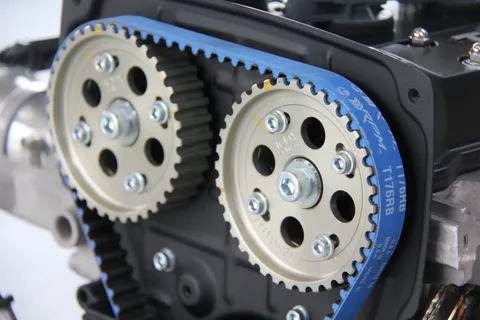Timing Belt Replacement A Comprehensive Guide for Car Owners
The timing belt is one of the most critical components in your vehicle’s engine. It ensures that the engine’s camshaft...

The timing belt is one of the most critical components in your vehicle’s engine. It ensures that the engine’s camshaft and crankshaft rotate in sync, enabling the engine’s valves to open and close at the correct time. Despite its importance, the timing belt often goes unnoticed until it fails, potentially causing significant engine damage. In this guide, we’ll explore everything you need to know about timing belt replacement — from the signs of wear to the replacement process and the associated costs.
What is a Timing Belt?
A Timing Belt Replacement, sometimes referred to as a cam belt, is a rubber belt reinforced with fiberglass or steel that connects the camshaft to the crankshaft. This connection ensures that the engine’s valves and pistons work in harmony, preventing the pistons from colliding with the valves. The timing belt operates in an environment of high heat and friction, which is why it is subject to wear over time.
Why is Timing Belt Replacement Important?
Over time, a timing belt naturally degrades due to heat, wear, and tear. If the timing belt snaps or slips, the engine can suffer from severe damage, including bent valves, damaged pistons, and in extreme cases, a destroyed engine. Here are the key reasons why replacing the timing belt is crucial:
- Prevents Engine Damage: A failed timing belt can lead to catastrophic engine damage, resulting in costly repairs.
- Maintains Engine Performance: A well-maintained timing belt ensures your engine runs smoothly and efficiently, improving fuel economy and performance.
- Avoids Costly Repairs: Early detection of timing belt wear allows for timely replacement, avoiding the need for expensive engine repairs that could cost thousands of dollars.
When Should You Replace the Timing Belt?
The timing belt does not need to be replaced frequently, but it is essential to follow the manufacturer’s recommended replacement interval. Typically, the timing belt should be replaced between 60,000 and 100,000 miles (96,000 to 160,000 kilometers), but this can vary based on the make and model of your vehicle. It’s always best to check your vehicle’s owner manual for the manufacturer’s specific recommendation.
Signs That Your Timing Belt Needs Replacing:
- Engine Misfires: A worn or stretched timing belt can cause the engine to misfire or lose power.
- Unusual Noises: If you hear a ticking or slapping noise coming from the engine, it could indicate a problem with the timing belt or its tensioners.
- Oil Leaks: An oil leak near the timing belt cover can be a sign that the belt has started to wear down.
- Visual Cracks or Damage: If you can see visible cracks, fraying, or wear on the belt, it’s time to replace it.
- Engine Won’t Start: A snapped timing belt will prevent the engine from turning over, causing a complete failure.
The Timing Belt Replacement Process
Replacing the timing belt is not a simple DIY job, as it requires a certain level of mechanical expertise. The procedure involves several steps, and failure to follow them precisely can lead to engine damage.
- Preparation: Before starting, ensure that the engine is cool, and disconnect the car battery for safety.
- Remove Components: To access the timing belt, you will need to remove various engine components such as the serpentine belt, air intake, engine covers, and possibly even the water pump.
- Align the Engine: The engine’s crankshaft and camshaft must be properly aligned to ensure the correct timing. This step is crucial, as misalignment can cause severe engine damage.
- Remove the Old Timing Belt: Once everything is aligned, the old timing belt can be removed. Inspect the surrounding components, such as the pulleys and tensioners, for signs of wear or damage.
- Install the New Timing Belt: Place the new timing belt in the correct position, ensuring it is tightly fitted but not overly strained. Reinstall the pulleys and tensioners.
- Reassemble the Engine: After the new timing belt is installed, reassemble the engine components in reverse order. Make sure everything is securely tightened.
- Test the Engine: Finally, reconnect the battery and start the engine. Listen for any unusual sounds and check for any signs of leakage or misalignment.
Professional Timing Belt Replacement
Due to the complexity of the timing belt replacement process, it’s often best to leave the task to professionals. A certified mechanic will have the necessary tools and expertise to perform the replacement correctly. A professional replacement also ensures that the engine is aligned properly, reducing the risk of further damage.
Cost of Timing Belt Replacement
The cost of car Timing Belt Replacement Yeovil can vary depending on the make and model of your vehicle, as well as the labor rates at your local auto repair shop. On average, you can expect to pay between $400 and $1,000 for a timing belt replacement. This cost typically includes the timing belt, labor, and any additional components such as tensioners or pulleys that may need to be replaced. Luxury or foreign vehicles may have higher labor costs due to the complexity of the engine.
Additional Components to Replace
When replacing the timing belt, it’s a good idea to replace other components that work in conjunction with it. These may include:
- Timing Belt Tensioner: The tensioner keeps the timing belt taut. If it’s worn out, it could cause the new belt to fail prematurely.
- Water Pump: Since the water pump is often driven by the timing belt, it’s a good idea to replace it at the same time to avoid future labor costs.
- Pulleys: Pulleys guide the timing belt along its path. If any pulleys are worn or damaged, they should be replaced to ensure smooth operation.
Consequences of Ignoring Timing Belt Replacement
Neglecting to replace a worn timing belt can result in significant consequences, including:
- Engine Failure: A snapped timing belt can cause the engine’s valves and pistons to collide, resulting in severe damage and often requiring an engine rebuild.
- Increased Repair Costs: Ignoring the timing belt can lead to expensive repairs down the line, which could have been avoided with early replacement.
- Reduced Vehicle Value: A vehicle with a neglected timing belt is more likely to have engine problems, which can lower its resale value.
Conclusion
Timing belt replacement is a vital part of maintaining your vehicle’s engine health and preventing costly repairs down the road. By following the manufacturer’s recommended replacement intervals and addressing any warning signs early, you can extend the life of your engine and avoid expensive damage. Whether you choose to replace the timing belt yourself or seek professional help, understanding the process and the importance of this component will ensure that your vehicle continues to perform at its best for years to come.







